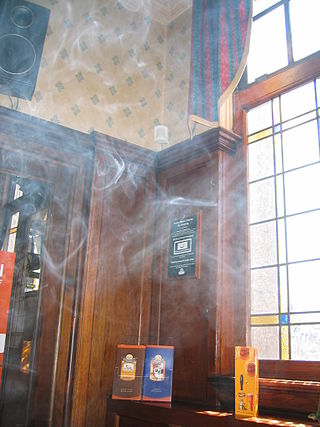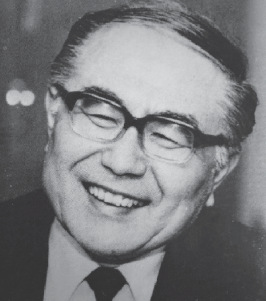Related Research Articles

A cigarette is a narrow cylinder containing a combustible material, typically tobacco, that is rolled into thin paper for smoking. The cigarette is ignited at one end, causing it to smolder; the resulting smoke is orally inhaled via the opposite end. Cigarette smoking is the most common method of tobacco consumption. The term cigarette, as commonly used, refers to a tobacco cigarette, but the word is sometimes used to refer to other substances, such as a cannabis cigarette or an herbal cigarette. A cigarette is distinguished from a cigar by its usually smaller size, use of processed leaf, and paper wrapping, which is typically white. Most modern cigarettes are filtered, although this does not make the smoke inhaled from them contain fewer carcinogens and harmful chemicals.

The tobacco industry comprises those persons and companies who are engaged in the growth, preparation for sale, shipment, advertisement, and distribution of tobacco and tobacco-related products. It is a global industry; tobacco can grow in any warm, moist environment, which means it can be farmed on all continents except Antarctica.

Smoking bans, or smoke-free laws, are public policies, including criminal laws and occupational safety and health regulations, that prohibit tobacco smoking in certain spaces. The spaces most commonly affected by smoking bans are indoor workplaces and buildings open to the public such as restaurants, bars, office buildings, schools, retail stores, hospitals, libraries, transport facilities, and government buildings, in addition to public transport vehicles such as aircraft, buses, watercraft, and trains. However, laws may also prohibit smoking in outdoor areas such as parks, beaches, pedestrian plazas, college and hospital campuses, and within a certain distance from the entrance to a building, and in some cases, private vehicles and multi-unit residences.

Passive smoking is the inhalation of tobacco smoke, called passive smoke, secondhand smoke (SHS) or environmental tobacco smoke (ETS), by individuals other than the active smoker. It occurs when tobacco smoke diffuses into the surrounding atmosphere as an aerosol pollutant, which leads to its inhalation by nearby bystanders within the same environment. Exposure to secondhand tobacco smoke causes many of the same diseases caused by active smoking, although to a lower prevalence due to the reduced concentration of smoke that enters the airway.

Cotinine is an alkaloid found in tobacco and is also the predominant metabolite of nicotine, typically used as a biomarker for exposure to tobacco smoke. Cotinine is currently being studied as a treatment for depression, post-traumatic stress disorder (PTSD), schizophrenia, Alzheimer's disease and Parkinson's disease. Cotinine was developed as an antidepressant as a fumaric acid salt, cotinine fumarate, to be sold under the brand name Scotine, but it was never marketed.

The Marlboro Man is a figure that was used in tobacco advertising campaigns for Marlboro cigarettes. In the United States, where the campaign originated, it was used from 1954 to 1999. The Marlboro Man was first conceived by Leo Burnett in 1954. The images initially featured rugged men portrayed in a variety of roles but later primarily featured a rugged cowboy or cowboys in picturesque wild terrain. The ads were originally conceived as a way to popularize filtered cigarettes, which at the time were considered feminine.
Steven J. Milloy is a lawyer, lobbyist, author and former Fox News commentator. Milloy is the founder and editor of the blog junkscience.com.

Nicotine marketing is the marketing of nicotine-containing products or use. Traditionally, the tobacco industry markets cigarette smoking, but it is increasingly marketing other products, such as electronic cigarettes and heated tobacco products. Products are marketed through social media, stealth marketing, mass media, and sponsorship. Expenditures on nicotine marketing are in the tens of billions a year; in the US alone, spending was over US$1 million per hour in 2016; in 2003, per-capita marketing spending was $290 per adult smoker, or $45 per inhabitant. Nicotine marketing is increasingly regulated; some forms of nicotine advertising are banned in many countries. The World Health Organization recommends a complete tobacco advertising ban.

Tobacco products, especially when smoked or used orally, have negative effects on human health. Researchers have addressed concerns about these effects for a long time. They have focused primarily on cigarette smoking.

Smoking in Argentina accounts for 15% of total tobacco consumption in the Americas. In the 20th century, the government promoted settlement and economic development in the northern subtropical zones, with tobacco playing a central role. A new government agency worked to educate farmers and promote the cultivation, processing, and marketing of tobacco. While tobacco factories were initially concentrated around Buenos Aires, they gradually extended into the northern production regions. By 1960, Argentina accomplished self-sufficiency in tobacco production. By the 1970s, its annual output exceeded 60,000 metric tons, with one-third exported. At the local level cooperatives are active, they sell to one of two multinational companies, Nobleza-Picardo, an affiliate of the British American Tobacco company, and Messalin-Particulares, associated with Philip Morris International. Argentina held the global rank of third place in terms of production, trailing behind Brazil and Mexico.
Operation Berkshire is the name of a program initiated in 1976 by seven of the world's major tobacco companies aimed at promoting "controversy" over smoking and disease.
The Tobacco Institute, Inc. was a United States tobacco industry trade group, founded in 1958 by the American tobacco industry. It was dissolved in 1998 as part of the Tobacco Master Settlement Agreement.
Smoking in China is prevalent, as the People's Republic of China is the world's largest consumer and producer of tobacco. As of 2022, there are around 300 million Chinese smokers, and 2.4 trillion cigarettes are sold there every year, 46% of the world total.
Geoffrey C. Kabat is an American epidemiologist, cancer researcher, and author. He has been on the faculty of the Albert Einstein College of Medicine and State University of New York, Stony Brook. He was co-author of a discredited BMJ study funded by the tobacco industry, that erroneously said there was no association between secondhand smoke and health problems.
Michael B. Siegel is an American tobacco control researcher and public health researcher. He is a professor of community health sciences at the Boston University School of Public Health.

Takeshi Hirayama was a Japanese cancer epidemiologist and anti-tobacco activist who served as the chief of the epidemiology division at the National Cancer Center in Tokyo from 1965 until 1985. He has been credited with publishing the first study linking passive smoking to lung cancer, and also conducted research on the relationship between certain dietary factors and cancer.
The Center for Indoor Air Research was a tobacco industry front group established by three American tobacco companies—Philip Morris, R.J. Reynolds, and Lorillard—in Linthicum, Maryland, in 1988. The organization funded research on indoor air pollution, some of which pertained to passive smoking and some of which did not. It also funded research pertaining to causes of lung cancer other than passive smoking, such as diet. The organization disbanded in 1998 as a result of the Tobacco Master Settlement Agreement.
The University of California, San Francisco (UCSF) Truth Tobacco Industry Documents is a digital archive of tobacco industry documents, funded by Truth Initiative and created and maintained by the University of California, San Francisco. The Library is a part of the larger UCSF Industry Documents Library which also includes the Drug Industry Document Archive, the Food Industry Documents Archive and the Chemical Industry Documents Archive. TTID contains over 14 million documents produced by major tobacco companies and organizations, many of them internal strategic memoranda made public as a consequence of the Tobacco Master Settlement Agreement. The documents deal with the tobacco industry's advertising, manufacturing, marketing, sales, and scientific research activities for the last century. Researchers, journalists, students, and activists interested in tobacco control issues and public health policies use the Library extensively to investigate tobacco industry strategies. Research in this archive revealed the tobacco industry playbook and its parallels with techniques linked to climate change denial.

Tobacco-free college campuses are colleges and universities that have implemented policies prohibiting the use of tobacco products at all indoor and outdoor campus locations. Tobacco is known to be harmful to the health of smokers, bystanders, and the environment. Since this issue was first recognized, colleges have been creating policies for tobacco use on campus in an effort to improve health standards, provide more enjoyable campus conditions, and to reduce the negative environmental effects of tobacco.
Good Epidemiological Practices or Good Epidemiology Practices (GEP) was a set of guidelines produced by the U.S. Chemical Manufacturers Association (CMA) in 1991 to improve epidemiologic research practices. It was then adopted by the tobacco industry around 1993 as part of its "sound science" program to counter criticisms of the industry on health and environmental issues such as secondhand smoke. It failed to make much impact on the US and European regulators, but may have had more influence in its later manifestations in Asia and particularly China.
References
- ↑ "Faculty Profiles". UCSF. Retrieved 18 March 2014.
- 1 2 3 Robinson, Mark. "Tilting at Tobacco". Stanford University. Retrieved 16 December 2014.
- ↑ "UCSF settles sexual harassment suit involving star researcher". STAT. 2018-10-16. Retrieved 2019-01-07.
- 1 2 S. Glantz, et al., "The Cigarette Papers", University of California Press, 1996
- ↑ S. Glantz, Primer of Biostatistics (6 ed), McGraw-Hill, 2005
- ↑ "Faculty". ucsf.edu. Archived from the original on 2014-02-21.
- 1 2 Asimov, Nanette (October 19, 2018). "UCSF agrees to $150K settlement over sexual harassment claim". San Francisco Chronicle.
- 1 2 Oransky, Ivan; Marcus, Adam (October 16, 2018). "UCSF settles sexual harassment suit involving star researcher". STAT.
- 1 2 Waxmann, Laura (March 28, 2018). "UCSF professor faces second sexual harassment lawsuit". San Francisco Examiner.
- 1 2 Howe, Rob (20 May 1996). "Battle of the Butts". People. Archived from the original on 27 April 2015. Retrieved 19 April 2015. ()
- 1 2 "Stanton A. Glantz, PhD". University of California. Retrieved 18 December 2014.
- ↑ "Our History". Stanford Engineering (Stanford University). Retrieved 18 December 2014.
- 1 2 3 4 "Stanton A. Glantz, PhD". University of California. Archived from the original on 16 December 2014. Retrieved 16 December 2014.
- ↑ "Stanton Glantz, PhD". University of California, San Francisco. Archived from the original on 4 December 2010. Retrieved 19 April 2015.
- ↑ Bach, John. "Anti-smoking crusader: Stanton Glantz, Eng '69". UC Magazine (University of Cincinnati). Retrieved 18 December 2014.
- ↑ Barnoya, J; Glantz, SA (24 May 2005). "Cardiovascular effects of secondhand smoke: nearly as large as smoking". Circulation. 111 (20): 2684–98. doi: 10.1161/CIRCULATIONAHA.104.492215 . PMID 15911719.
- ↑ Sargent, Richard P.; Shepard, R. M.; Glantz, S. A. (5 April 2004). "The Helena Study (Abstract)". BMJ. 328 (7446): 977–980. doi:10.1136/bmj.38055.715683.55. PMC 404491 . PMID 15066887 . Retrieved 2007-05-01.
- ↑ Alzahrani, T; Pena, I; Temesgen, N; Glantz, SA (Oct 2018). "Association Between Electronic Cigarette Use and Myocardial Infarction". American Journal of Preventive Medicine. 55 (4): 455–461. doi:10.1016/j.amepre.2018.05.004. PMC 6208321 . PMID 30166079.
- ↑ Glantz, SA; Barnes, DE; Bero, L; Hanauer, P; Slade, J (1995). "Looking through a keyhole at the tobacco industry. The Brown and Williamson documents". JAMA. 274 (3): 219–24. doi:10.1001/jama.1995.03530030039032. PMID 7609230.
- ↑ S. Glantz and E. Balbach. "Tobacco War: Inside the California Battles", University of California Press, 2000
- ↑ PBS Frontline, Interview with Stanton Glantz for Smoke in the Eye, 1999.
- ↑ "Study Confirms Tea Party Was Created by Big Tobacco and Billionaire Koch Brothers". The Huffington Post. 11 February 2013.
- ↑ JAMA Pediatrics, 6 March 2014, Electronic Cigarettes and Conventional Cigarette Use Among US Adolescents, retrieved 6 Mar 2014
- ↑ Sabrina Tavernise, "Young Using E-Cigarettes Smoke Too, Study Finds" New York Times March 6, 2014
- ↑ Public Health Consequences of E-Cigarettes : Health and Medicine Division. The National Academies Press. 2018. ISBN 9780309468343.
{{cite book}}:|website=ignored (help) - ↑ Glantz, SA; Nguyen, N; Oliveira da Silva, AL (2024). Population-Based Disease Odds for E-Cigarettes and Dual Use versus Cigarettes, NEJM Evidence, https://evidence.nejm.org/doi/full/10.1056/EVIDoa2300229
- ↑ https://pubpeer.com/publications/9E38A75C420D1F19DA0D48C37FA8D8
- ↑ https://pubpeer.com/publications/9E38A75C420D1F19DA0D48C37FA8D8#2
- ↑ "Tobacco Control Archives". University of California, San Francisco. Retrieved 6 March 2019.
- ↑ Hochschild, Adam (March 1996). "Shoot-Out in Marlboro Country (cont'd)". Mother Jones . Retrieved June 2, 2013.
- ↑ "'Death in the West' to be resurrected". The Herald (Glasgow) . May 11, 1982. p. 6. Retrieved June 2, 2014.
- ↑ "ree Curriculum Guide and Broadcast of 'death in the West' 000129 and 000131". Tobacco Documents Online. Archived from the original on 2014-12-16. Retrieved 16 December 2014.
- ↑ S. Glantz, Tobacco: Biology and Politics Archived 2007-03-01 at the Wayback Machine , WRS HealthEdCo
- ↑ Karen Butter; Robin Chandler & John Kunze (November 1996). "The Cigarette Papers: Issues in Publishing Materials in Multiple Formats". D-Lib Magazine.
- ↑ Wiener, Jon (1 January 1996). "The Cigarette Papers". PBS. Retrieved 17 December 2014. This is an authorized reprint of an article that appeared in The Nation in 1994.
- ↑ "Cigarette Wars". CNBC. Retrieved 8 March 2015.
- ↑ "Merchants of Doubt". Sony Pictures Classics. Retrieved 8 March 2015.
- ↑ PBS Frontline, Interview with Stanton Glantz for Inside the Tobacco Deal, 1997
- ↑ Brion J. Fox J.D., James M. Lightwood Ph.D., and Stanton A. Glantz Ph.D., "A Public Health Analysis of the Proposed Resolution of [the 1997 United States] Tobacco Litigation" (February 1, 1998). Center for Tobacco Control Research and Education. Tobacco Control Policy Making: United States. Paper US1998. http://repositories.cdlib.org/ctcre/tcpmus/US1998
- ↑ "A High-Profile Anti-Tobacco Crusader Is Being Sued For Sexual Harassment". Buzzfeed. December 7, 2017.
- ↑ "Former UCSF researcher sues UC regents, UCSF professor for alleged sex harassment". The Daily Californian. December 7, 2017.
- ↑ "UCSF professor, prominent tobacco control activist accused of sexual harassment by former mentee". San Francisco Examiner.
- ↑ O'Lonergan, Theresa. "UCSF letter to American Association for Cancer Research (PDF)" (PDF). Retrieved 2 January 2021.
- ↑ "Settlement Agreement and Release of All Claims (PDF)" (PDF). Retrieved 13 November 2020.